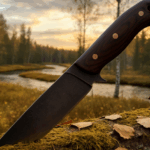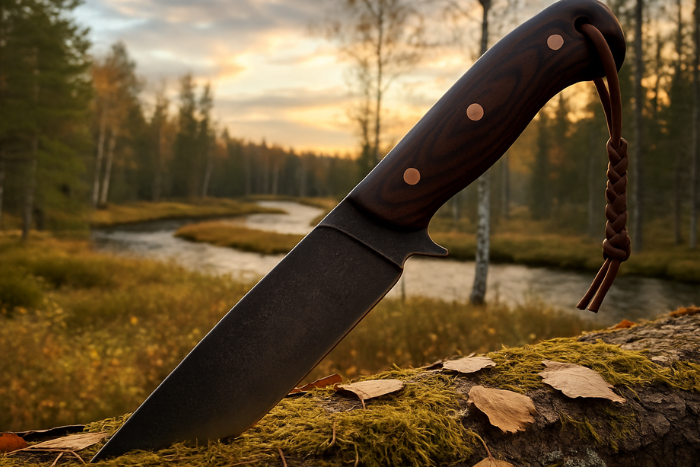

Marcus had finally saved enough to commission his dream knife. He had spent months researching blade steels, studying different grinds, and understanding heat treatment processes. When he contacted the knife maker, he was ready to discuss every detail of the blade until the conversation turned to the handle.
“What material do you want for the handle?” the maker asked. Marcus paused. He had spent so much time focused on the blade that he had not seriously considered the handle.
“Does it really matter that much?” he asked.
The knife maker smiled because he had heard this question many times before. “The blade does the cutting,” he explained, “but the handle is what connects you to that blade. The wrong handle material or design can make even the finest blade uncomfortable, unsafe, or impractical for your intended use. The handle deserves as much thought as the blade itself.”
The handle of a custom knife represents far more than just a place to grip the blade. It is the interface between tool and user, affecting comfort, control, safety, and the overall experience of using the knife. Handle materials and design considerations impact how the knife feels in your hand, how it performs during extended use, whether it remains secure in wet or cold conditions, and how well it withstands the environmental conditions it will face. Understanding these factors helps you make informed decisions when commissioning a custom knife that will serve you well for decades.
Wood remains one of the most traditional and popular handle materials for custom knives, and for good reason. Quality hardwoods like walnut, maple, oak, and exotic species offer natural beauty, comfortable feel, and excellent working properties for knife makers. Each piece of wood is unique, with grain patterns and color variations that make every knife one of a kind. Wood handles develop character over time, acquiring a patina from use that tells the story of the knife’s life. For collectors and users who appreciate natural materials and traditional aesthetics, wood handles provide unmatched visual appeal.
However, wood handles require consideration of practical factors. Different wood species offer varying degrees of durability and moisture resistance. Dense hardwoods like cocobolo, desert ironwood, and bocote provide excellent durability and natural oils that resist moisture better than softer woods. Stabilized wood, where the wood is impregnated with resin under pressure, dramatically improves moisture resistance and dimensional stability while maintaining the natural appearance. For knives that will see hard outdoor use or exposure to water, stabilized wood or naturally oily hardwoods represent better choices than untreated domestic hardwoods.
Me
The texture and grip of Micarta can be customized through different base materials and surface treatments. Canvas Micarta provides more texture than linen Micarta, offering better grip in wet conditions. The surface can be left smooth for comfortable extended use or textured for maximum grip. Micarta is available in various colors, though earth tones and black remain most popular for traditional knife aesthetics. While Micarta lacks the visual warmth of natural wood, its performance advantages make it a top choice for serious users who prioritize function over appearance.
G10 represents another high performance composite material gaining popularity in custom knife handles. Similar to Micarta but made with fiberglass cloth and epoxy resin, G10 offers even greater strength and lighter weight. It is completely impervious to moisture, extremely durable, and provides excellent grip. G10 is available in numerous colors and patterns, allowing for creative design considerations that are not possible with traditional materials. The material machines cleanly and takes a beautiful finish, making it popular with knife makers who want reliable working properties.
The main consideration with G10 is that it can feel somewhat synthetic compared to natural materials. Some users find it less comfortable during extended use than wood or Micarta, particularly in cold conditions where it does not warm to hand temperature as readily. However, for tactical knives, hard use outdoor knives, or any application where maximum durability and weather resistance are priorities, G10 delivers exceptional performance. The material’s strength also allows for thinner, lighter handle designs without sacrificing durability.
Carbon fiber has emerged as a premium handle material for custom knives where weight savings and high tech aesthetics are valued. This advanced composite material offers an exceptional strength to weight ratio, making it ideal for knives where every ounce matters. Carbon fiber is completely moisture proof, extremely durable, and provides a distinctive modern appearance with its characteristic weave pattern. For collectors who appreciate cutting edge materials and users who want the lightest possible knife without compromising strength, carbon fiber represents the ultimate choice.
The primary drawbacks of carbon fiber are cost and grip characteristics. Carbon fiber is significantly more expensive than other handle materials and requires specialized tools and techniques to work properly. The smooth surface can be slippery in wet conditions unless textured or combined with other materials. Some knife makers address this by using carbon fiber for scales over a textured liner or by incorporating grip enhancing patterns into the carbon fiber layup. Despite these considerations, carbon fiber remains highly desirable for premium custom knives where its unique properties justify the additional cost.
Nature
Practical considerations with natural organic materials include durability and maintenance requirements. Antler and bone are porous and can absorb moisture, potentially leading to cracking or deterioration if not properly sealed and maintained. These materials are also less durable than modern synthetics and may not withstand hard use as well. For display pieces, gentleman’s folders, or knives that will receive careful use and maintenance, natural materials provide unmatched character. For hard use working knives, modern materials typically offer better performance.
Exotic materials like mammoth ivory, fossilized materials, and rare woods represent the pinnacle of custom knife handle materials for collectors. These materials offer unique beauty, historical significance, and extreme rarity that justify premium prices. Mammoth ivory, legally obtained from ancient remains, provides the prestige of ivory without ethical concerns. Fossilized woods and other ancient materials connect the knife to deep history. For collectors building premium knife collections, these exotic materials transform functional tools into genuine art pieces.
Handle shape and ergonomics represent critical design considerations that affect comfort and control during use. The handle should fit your hand size and shape, with contours that provide secure grip without creating pressure points during extended use. Handles that are too thin cause hand fatigue, while overly thick handles reduce control and dexterity. The cross sectional shape, whether round, oval, or rectangular, affects how the knife feels and rotates in your hand during different cutting tasks.
Finger grooves and contouring in handle design generate debate among knife users and makers. Sculpted handles with defined finger positions can provide excellent control and comfort for users whose hands match the intended size. However, aggressive contouring limits grip options and may be uncomfortable for users with different hand sizes. Many experienced users prefer handles with subtle contouring that suggests hand position without forcing it, allowing multiple grip positions for different tasks. When commissioning a custom knife, consider how you will actually use it and whether you need the flexibility of a less sculpted handle.
The handle to blade ratio affects balance and handling characteristics. Kitchen knives typically benefit from blade heavy balance that allows the blade weight to do the cutting work. Outdoor and survival knives often work better with more neutral balance or slight handle weight that reduces fatigue during extended use. Tactical knives may prioritize quick handling and point control. Discuss intended use with your knife maker so they can optimize the handle design for proper balance and handling characteristics.
My constru
Handle length
texture
Color and aesthetic considerations allow you to personalize your custom knife to match your preferences or collection theme. Natural wood colors range from pale maple to dark walnut, with exotic woods offering reds, purples, and striking grain patterns. Synthetic materials like Micarta and G10 are available in numerous colors, allowing for creative combinations or matching specific aesthetic preferences. Some collectors build themed collections with consistent handle materials and colors, while others appreciate variety. Your knife maker can help you select materials and colors that achieve your desired aesthetic.
Maintenance requirements vary significantly among handle materials. Synthetic materials like Micarta, G10, and carbon fiber require virtually no maintenance beyond basic cleaning. Wood handles benefit from occasional treatment with mineral oil or specialized wood conditioners to maintain appearance and prevent drying. Natural materials like antler and bone may require more careful maintenance to prevent moisture damage. Consider how much maintenance you are willing to perform when selecting handle materials for your custom knife.
Cost considered
At JWBS Knives, we work with a wide range of handle materials to create custom knives that perfectly match each client’s needs and preferences. Whether you prefer the natural beauty of carefully selected hardwoods, the performance advantages of modern synthetics, or the prestige of exotic materials, we can help you select the optimal combination of materials and design for your custom knife. Our experience with different materials and handle designs ensures your knife will not only look beautiful but perform comfortably and reliably for years of use.
The handle of your custom knife deserves as much thoughtful consideration as the blade itself. The right combination of material, shape, size, and finish transforms a quality blade into a knife that feels like an extension of your hand. Take time to consider how you will actually use the knife, what conditions it will face, and what aesthetic appeals to you. A well designed handle makes every use of the knife more enjoyable and effective.
If you are planning to commission a custom knife, contact JWBS Knives to discuss your handle material options and design preferences. We will help you understand the advantages and tradeoffs of different materials and create a handle design that perfectly complements your blade and meets your specific needs. Let us work together to create a custom knife that you will be proud to own and use for decades to come.
About JWBS Knives
JWBS Knives specializes in hand forged custom knives for collectors and outdoor enthusiasts. Each blade is individually crafted with attention to quality, performance, and traditional knife making techniques.
Contact JWBS Knives:
Phone: (615) 406-6370
Email: Info@jwbsknives.com
Websitehttps://jwbsknives.com
Location: Hendersonville, TN
Facebookhttps://www.facebook.com/JWBSForgesknives/
Instagramhttps://www.instagram.com/jwbsknives
Join our newsletter and stay up to date on all the custom products jwbsknives has to offer and read about custom techniques we use in the Forging Process of your next Hand Crafted Knife and Accessories.
After order is placed we will contact you about shipping cost with your choice of carrier.